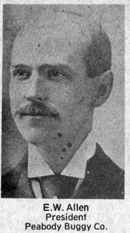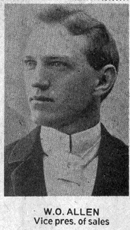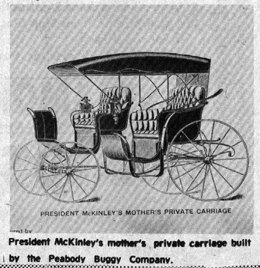October 30, 1980




A hundred years or more ago Fostoria was a rapidly growing town with a population of 7,000…having grown from almost 1,000 in 1860 just six years after Rome and Risdon merged to form our village.
Our ancestors caused Fostoria to boom by supplying most of its needs through the establishment of local manufacturing plants. And one of those was the manufacture of horsedrawn wagons and buggies…essential in those days for transportation and movement of products in and out of town. Every farmer in the area needed one ore more wagons and a buggy to bring the family to town.
A mini-sized directory published in 1877 listed five companies making wagons or buggies, or both. It may be that those were established prior to 1877, but I am unable to ascertain.
THE FIRST FIVE
Ernest & Dole, at the corner of South and Wood streets, made wagons and carriages; Billyard & Huth, located at Main and South streets, made only carriages; Doke & Ersig, Center Street, east of Main, made wagons and carriages; William Mergenthaler, 125 E. Tiffin St., also made both vehicles; A.T. McDonel, at the corner of South and Wood streets, made carriages and buggies.
Back then, there were single seated buggies and the larger versions for the family.
In the carriage category there were hacks, which resembled the stagecoach, and met all the passenger trains. Fancy carriages were an important item for the well-to-do families. And all the undertakers had specially-made carriages for the bereaved family and for transporting the caskets.
All of these types of products were made by the skilled wood-workers in the shops in Fostoria. In the same way that automakers today are supplied parts by others, so the wagon buggy and carriage makers had suppliers; and many of those were also local manufacturers, primarily the lumber mills.
SPURRED LOCAL ECONOMY
It should not be overlooked that wagons and buggies contributed to the economy in other ways. There were the horse shoers, who were also blacksmiths, and there were stables where a horse and buggy could be rented.
By 1890, all of the buggy, wagon and carriage makers listed in 1877 had disappeared from the local scene except Merganthaler, and two new names were added: John Andes, at 116 W. Center St., and Fostoria Buggy Co., North Union Street, where the Bendix autolite factory is located today. In fact, when the buggy industry died, the original Autolite plant, with C.O. Miniger, a local man, started in the Peabody Carriage Co. building.
John Andes was the owner of the building which still stands at Main and Center Streets bearing his name at the top, and which housed the Opera House back then.
William Merganthaler, named above, was the father of Andy, the banker, connected with the First National Bank, and Charles, another son, was a leading jeweler here. The Merganthaler family lived at East North and Poplar streets and the house still exists.
PROBABLY IN 1893
In 1893, Fostoria Buggy Co., had failed or quit for reasons unknown, but the Peabody Buggy Co., headed by W.O. and E.W. Allen had taken over their well equipped building, and were destined to become the largest manufacturer of buggies and carriages in Fostoria, perhaps the state, even though they didn’t last as long as several others.
One of the accompanying illustrations shows the Peabody factory as it appeared in a publication back then. Another illustration, loaned by Florence (Manecke) Evans, shows the carriage made by Peabody for President McKinley’s mother.
E.W. Allen, a local banker, was president and treasurer of Peabody, and his brother W.O., was vice president and sales manager. Both had previously been involved in the wholesale and retail part of the business. Mr. H.A. Shambaught was secretary.
STILL OTHERS
Other local people who had become identified in the making of wagons and carriages by 1893 were: Eissler Bros., 129 E. Center St.; Jacob Eissler and Sons, 121 E. Center St.; Krabill & Krabill, 303 N. Main St.; McNall & McCune, 111 S. Main St. In 1896, S.J. Ernest started in business at 142 Perry St.
The business decline of the 1890’s took a toll in the buggy and wagon business, and by 1899 the only local manufacturers who survived were the two Eisslers, Mergenthaler and Peabody.
The 1903 directory showed both of the Eisslers still on E. Center; J.G. Inscho had taken over the business at 142 Perry St.; and Peabody was still in operation.
By 1910, business had recovered from the bad times of the 1890’s and there were some new names: A.C. Hoyt & Co., 308 N. Main St.; James A. Manecke, 128 E. Center St.; L.R. Wade, 130 E. Center St.; along with two Eissler families and Peabody.
CHANGING TIMES
Henry Ford’s horseless carriage, first produced in 1903, was serious competition for the horsedrawn vehicles, and by 1910 was casting a shadow on the makers of wagons and buggies.
In 1916, Fred Eissler was still in business as was Peabody. However, it was the last year Peabody was listed as a manufacturer.
The Allen brothers knew when an era had ended and had made plans accordingly. It was in 1912 that Allen Motor Car Co. started producing their new models in Fostoria.
In 1920, the Fred Eissler shop was still in operation, and Eissler Bros., 129-131 E. Center St., was taken over by several men who had been associated with other manufacturers of buggies and wagons. They were William E. Cook, who with his father was with Peabody for many years, Charles Stewart and H.M. Hahn. The new manufacturer was known as Cook Carriage Co., with a shop also in Bloomdale.
The next few years saw a continuing decline in the wagon and buggy business. By 1926, Cook Carriage had been forced to convert to repair work on car bodies and tops; and Fred Eissler was doing blacksmithing.
DISASTROUS FIRE
Cook Carriage experienced a disastrous fire which burned the old frame building to the ground in 1945 or 1946. They were the last of the many manufacturers of those vehicles which were important to that era, and which meant so much for the business climate of Fostoria.
After the fire, William Cook started an upholstery shop on East Center Street, and LaMar, his son continued to operate it after his father died. LaMar had his shop in other places in this area and retired several years ago.
Charles Stewart, retired after the fire and devoted his time to the YMCA of which he had been president for many years.
LAST ONE BY COOK
The last open type buggy made by Cook Carriage is shown by one of the accompanying illustrations, with George Shaffer, former Fostorian, in the driver’s seat. The photo is the possession of Leroy Stewart, son of Charles, who has lived in Boulder, Colo., for many years. Mrs. Stewart was the former Zoa Hatchet… they were classmates in the FHS class of 1920.
Several years ago, Mrs. Earl Titus, 905 N. Main St., gave this writer a small metal insignia plate which was evidently attached to completed buggies. It reads – “Manufactured by The Columbia Buggy Co., Fostoria, Ohio”.
Nowhere in my research did I come across that name. Therefore, I conclude that it was in business before there was a directory in Fostoria, which further prompts me to say that there may have been other manufacturers of buggies and wagons which are not listed in this article.
I will be pleased to get additional facts on the subject.